Ribbons User Manual
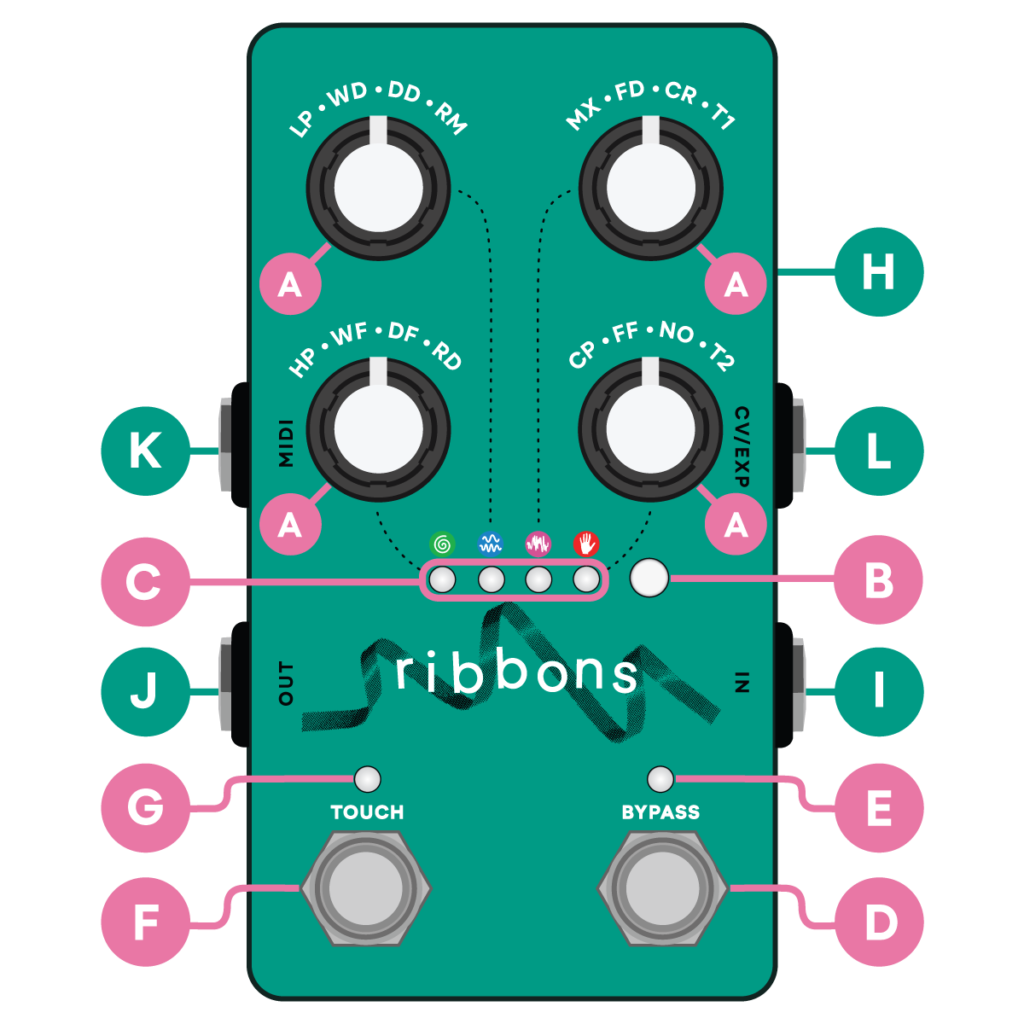
Contents
- About Ribbons
- Getting Started
- Tape Effects
- Presets
- Touch Modes
- Four-Track Looper
- MIDI Overview
- CV / Expression
- Mixing and Bypass Options
- Factory Reset
- Firmware Updates
About Ribbons
Ribbons is a powerful compact toolkit that celebrates the idiosyncrasies of imperfect mediums and translates them into a simple, flexible interface that gives you tons of control.
Customize a massive range of sounds from pristine and hi-fi, to warbley, aged and mangled. Its lush reverb, playful Touch Modes, and four-track looper bring Ribbons to life, unlocking endless possibilities for creating soundscapes and experimental compositions.
Controls
A. Knobs
B. Push button
C. Page and parameter LEDs
D. Bypass footswitch
E. Bypass LED
F. Touch footswitch
G. Touch LED
Inputs and Outputs
H. Power input
I. TRS stereo input
J. TRS stereo output
K. MIDI input
L. CV / EXP input
The content in this manual reflects firmware version 1.3, which we released in April 2023.
Have questions? Join the Kinotone community to connect with us and other users at forum.kinotoneaudio.com
For direct support email support@kinotoneaudio.com
Getting Started
Take care to use an isolated +9VDC center-negative power supply rated for at least 160 mA.
Ribbons passes a stereo in / stereo out signal by default via TRS input and output jacks. To use it in stereo you will need to use TRS style cables.
We do not recommend using Ribbons with a daisy chain. Be sure to reduce the volume on your amplifier or audio playback system when applying power. Like many devices, it may produce a subtle 'pop' sound.
Use the Bypass footswitch to engage or disengage Ribbons.
- If the Bypass LED is ON, effects are engaged.
- If the Bypass LED is OFF, effects are disengaged.
Tape Effects
When you power on Ribbons, its default mode allows you to edit the tape effects, which broadly refers to the different parameters abbreviated on the front panel.
4 knobs have unique controls across 4 pages. Each page is color-coded with a thematic icon. Press the push button to toggle between the pages.

Page 1 — Mix and Utility
Page 2 — Wow and Flutter
Page 3 — Degradation
Page 4 — Reverb, Touch Modes
![]() The spiral page has a dedicated mix knob, high and low pass filters, and compression.
The spiral page has a dedicated mix knob, high and low pass filters, and compression.![]() A pair of sine waves representing wow (slow) and flutter (fast) oscillation.
A pair of sine waves representing wow (slow) and flutter (fast) oscillation.![]() A degraded, noisy signal, for more asynchronous and unpredictable effects.
A degraded, noisy signal, for more asynchronous and unpredictable effects.![]() A hand representing touch. This last page includes controls for the reverb, as well as the different Touch Modes.
A hand representing touch. This last page includes controls for the reverb, as well as the different Touch Modes.
Visual feedback
The page and parameter LEDs track which page you’re on, and show you the value of your parameters.
When you switch to a new page, the LED beneath the icon lights up briefly to indicate which page you’re on. Then, all 4 LEDs settle to show you how your parameters are currently set for that page.
Dotted lines illustrate how each knob connects with an LED. As you turn a knob clockwise, the color intensity changes from its base color to glowing white, with some white introduced at 12 noon.
The LEDs are a visual guide. By not only listening, but also monitoring the intensity of the LEDs, you can easily track your settings when jumping from page to page.
Relative knobs
When you switch pages, the physical position of a knob and its parameter may be momentarily misaligned.
When this occurs, controls are responsive in a relative way, meaning that the knob will attenuate or increase the parameter based on the actual amount of space that’s available. Once they match up, the knob will start tracking again as you’d expect.
This sounds complicated but it’s really simple, and you should get a feel for it pretty quickly by watching the LEDs.
IMPORTANT: You don't lose your settings when jumping from one page to another. All of Ribbons’ parameters work together, so dialing in your desired effect is a matter of adjusting the knobs on each page. If you ever feel like starting over — no worries. Load up preset 1 to reset the tape effects to a completely transparent state. Powering off and on won’t help, since Ribbons remembers your last used settings between power cycles.
 Page 1 — Mix and Utility
Page 1 — Mix and Utility
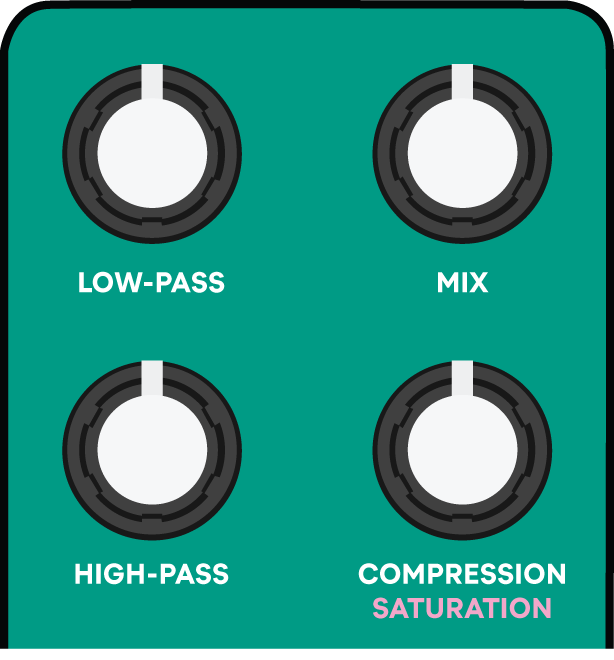
MIX (MX) — Ribbons has a dedicated mix knob for all of its sounds and effects. This is thoughtfully designed so that so you can blend dry and wet signals without phasing issues.
The main use case for this knob is to use it in conjunction with the different modulation settings. For example, at 100% mix you can get a tape-like vibrato, at 50% a lush chorus, and at zero you’ll get no effects at all — just your dry signal.
LOW-PASS (LP) — A slightly resonant four-pole virtual analog low-pass filter. Rotating the knob counter-clockwise removes treble and brightness from your signal.
HIGH-PASS (HP) — A symmetrical and opposite high-pass filter. Rotating the knob clockwise removes bass and boominess from your signal.
Ribbons’ filters are modeled after the filter from a very famous 1970s synthesizer. If you have suddenly lost effects and are unsure why, double check your page 1 settings. By design you can completely filter out incoming audio by turning the LP knob all the way left, or the HP knob all the way right. You will also of course lose effects by turning the MIX knob down.
COMPRESSION (CP) — Controls the dynamics of your incoming audio and attenuates the loudest sounds. As you increase it, your audio will feel warmer and more balanced.
When used on guitar it can add some amazing sustain to your notes, and on full mixes it has a magical way of gluing your sounds together without distorting them.
Ribbons’ compression algorithm is modeled after a vinyl simulator found in a sampler that was used to make a number of classic hip hop records.
There is also TAPE SATURATION if you’d prefer that here instead of compression. You can swap out the CP knob for a saturation parameter by sending MIDI CC 52, value >0. This change is persistent between power cycles unless you switch it back.
If you apply a change via MIDI you must press the push button and then wait 10 seconds for your unit to save state.
If you don’t use MIDI, we created a special firmware file you can install that enables saturation as the default parameter.
 Page 2 — Wow and Flutter
Page 2 — Wow and Flutter
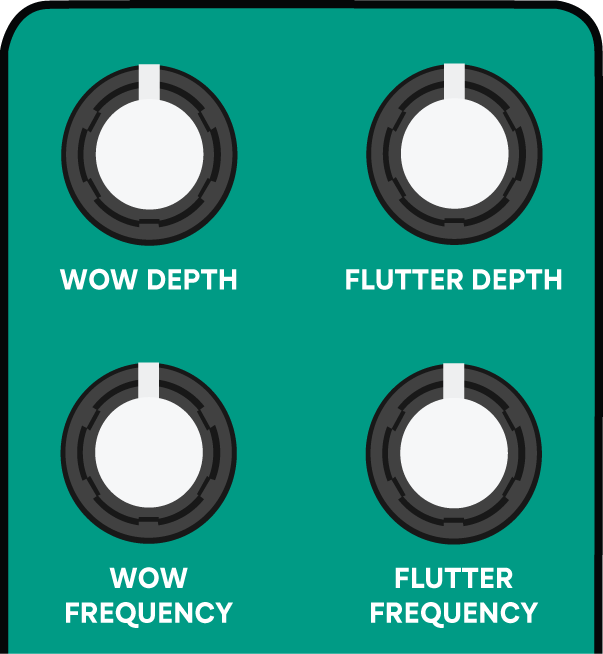
Wow emulates slower pitch variations caused by malfunctioning components in a tape transport. So something like a worn out belt or deformed rubber rollers.
WOW DEPTH (WD) — By turning up depth, your audio’s pitch will start to randomly wobble. As you increase it, the intensity of the variation gets more dramatic.
WOW FREQUENCY (WF) — Changes the max speed at which these variations occur.
Flutter emulates faster and more jittery pitch variations sometimes found on tape players. This can be caused by things like bent capstans, backlash from worn out gears, or other obstructions in the tape path that create unexpected friction.
FLUTTER DEPTH (FD) — Turning up depth will introduce subtle, stuttery pitch variations in your signal.
FLUTTER FREQUENCY (FF) — As you increase frequency, the variations become more chaotic.
Ribbons' random wow and flutter parameters are modeled after spectral and waveform data collected from all kinds of tape players, ranging from perfectly functioning to completely broken — four-track cassette machines, reel-to-reels, dictaphones, mangled cassette loops, tape delays, and more.
 Page 3 — Degradation
Page 3 — Degradation
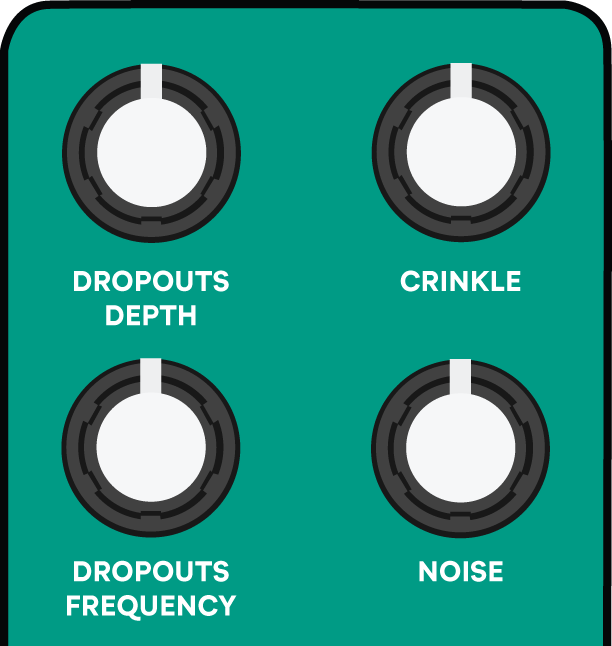
Dropouts emulate the sound of tape getting stuck momentarily and then catching up. So think physical interruptions, like tape getting snagged on an object, or intentionally manipulating a tape during playback.
DROPOUTS DEPTH (DD) — Controls the max intensity of a dropout when it occurs.
DROPOUTS FRQUENCY (DF) — Controls the probability of a dropout occurring.
CRINKLE (CR) — Emulates surface-level imperfections on a wrinkly piece of cassette tape. By turning up this knob you crumple up the tape more and more. You’ll hear brief moments of signal loss as the tape separates from the tape head.
Dropouts and crinkle provide separate processing on the left and right channels, making them a great way to introduce some interesting variety across the stereo field.
NOISE (NO) — This knob gives you the ability to cross-fade between 2 flavors of noise: static hiss like you’d find on an old tape player, and clicks & pops reminiscent of a dusty, crackly record. You can easily dial in one or both using a single twist of the knob.
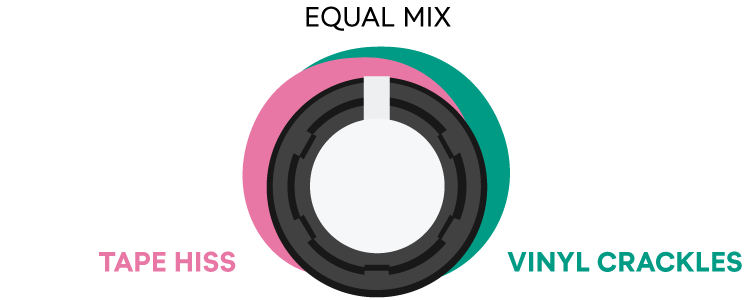
 Page 4 — Reverb, Touch
Page 4 — Reverb, Touch
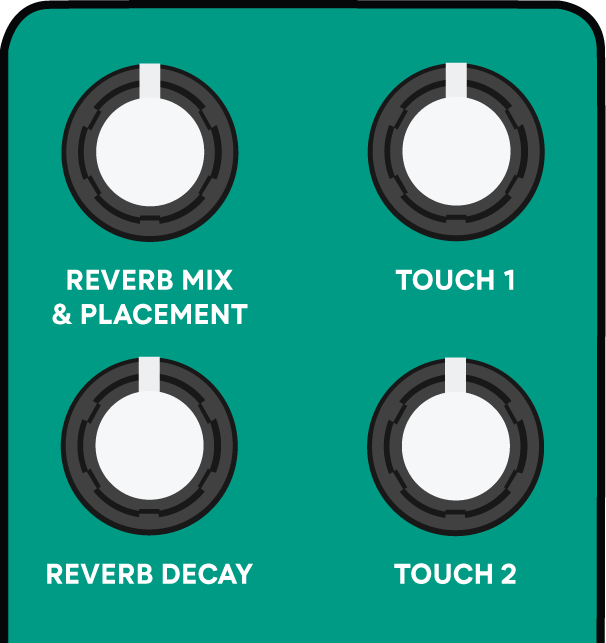
Page 4 has controls for the reverb, as well as the Touch Modes. A good way to remember this last page is:
red for reverb, hand for touch.
Ribbons’ reverb algorithm draws inspiration from the famous rack reverb units of the 70s and 80s. We carefully studied many of these designs and came up with our own unique structure that’s simple, elegant, and modern sounding. It’s a versatile tool, especially when used in combination with the other tape effects.
REVERB MIX & PLACEMENT (RM) — Both mix and placement are on the top-left knob, so you can control the amount of reverb applied, and where it goes in your signal chain, either before or after the other effects.

You can really change the character of the reverb by playing with the placement setting. Putting the reverb before the tape effects creates more of a haunting and aged sound, whereas putting it after allows it to ring out nice and clear.
REVERB DECAY (RD) — At its minimum decay time, the reverb sounds springy and echoey. As you increase it, the reverb tail becomes smoother and more diffuse.
At max decay it will ring out infinitely, creating a never-ending wash of ambient sound.
We once ran a test where we set the decay time to infinite and strummed a chord. A week later you could still hear that ghostly reverb tail droning along...
We’ll cover Touch Modes soon, but first up — presets.
Presets
Presets are a quick way to queue up some sounds Ribbons is capable of. To enter the Presets Menu, hold down the push button for 3 seconds. A single LED will light up, and now you can toggle through 8 preset slots: 1, 2, 3, 4 are red, and 5, 6, 7, 8 are blue.
To load a preset, hover over a slot and press Touch. The LEDs will all glow, and now you can hear the sounds of that preset affecting your incoming audio.
If you load up a preset and then press the push button or turn a knob, you are back to editing tape effects with that preset as a starting point. If you're jamming with one preset and want to try out a different one, you first have to re-enter the Presets Menu. NOTE: If your unit is configured for saturation, then saturation replaces compression in the presets.
Factory Presets:
1 — Init (no effects; transparent)
Wish you could start over? Not to worry. Load up Init to reset all of your tape effects to a completely transparent state.
Touch Mode: Magnetic Dance
LED pattern: green
2 — Chaotic Vibrato
This preset sets wow & flutter depth and frequency to 50%. The dry / wet mix is set to 100% to get a vibrato effect.
Touch Mode: Magnetic Dance
LED pattern: dark blue
3 — Chaotic Chorus
Same as Chaotic Vibrato but the dry / wet mix is set to 50% to get a chorus effect.
Touch Mode: Broken Machine
LED pattern: pink
4 — A Bit Lo-Fi
Just some high and low-pass filtering, dropouts, crinkle, and compression. Great for something subtle and musical.
Touch Mode: Tape Stop
LED pattern: red
5 — Crushed and Mangled
I think you really need to get your tape player fixed. A more extreme version of A Bit Lo-Fi.
Touch Mode: Crushed Cassette
LED pattern: orange
6 — Really Nice Compression
Some compression and low-pass filtering. Helps to control your dynamics and make things sound more balanced.
Touch Mode: Tape Stop
LED pattern: light blue
7 — Lo-Fi Ambient
Similar to A Bit Lo-Fi but this time with reverb. The reverb mix is set to 60% and the placement is set to pre-effects. This adds some compression and lo-fi character to the reverb tail, which has a haunting quality to it.
Touch Mode: Magnetic Dance
LED pattern: purple
8 — Endless Reverb
A simple patch showcasing the reverb parameter on its own with a very long decay time.
Touch Mode: Broken Machine
LED pattern: white
Saving your settings
To overwrite a preset with your current settings, enter the menu (hold push button for 3 secs) and hover over the slot you want to use. Press Bypass twice to confirm and save. To exit without loading or saving, simply hold down the push button again for 3 seconds.
If you ever find yourself ever wanting to restore the factory presets, check out the factory reset option.
Presets can also be loaded using your favorite MIDI controller or MIDI preset device.
Touch Modes
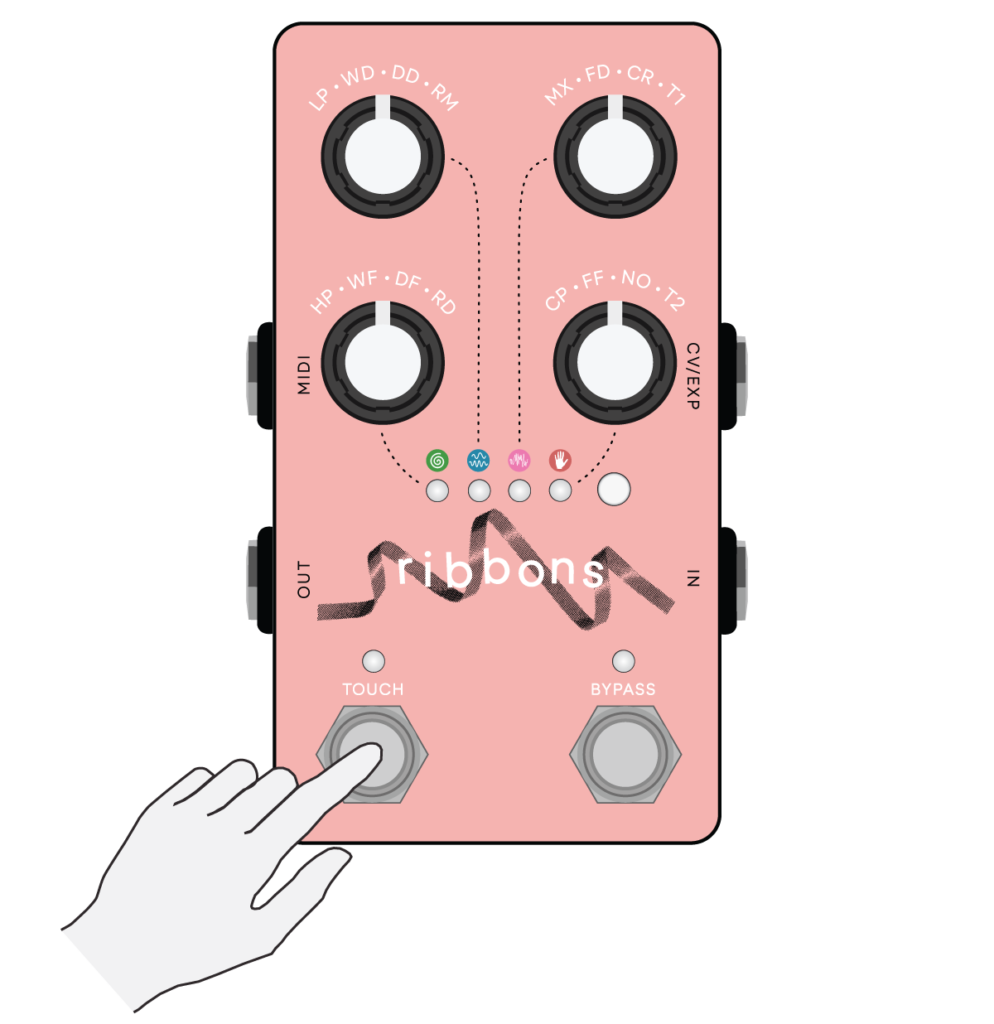
Ribbons has a number of playful Touch Modes that can be activated momentarily or latched, and interact with all of the different effects.
The functionality of the Touch footswitch depends on which mode is selected. The T1 and T2 knobs on page 4 provide controls. To change between Touch Modes, hold down the push button and press Touch.
The Touch LED lights up to indicate your Touch Mode:
- Magnetic Dance (green) — A granular micro-looper that you can tune to chords and play forward or backwards. Use it to freeze a grain of audio or create drones to play along with.
- Tape Stop (dark blue) — Slows down and bends the pitch of your audio, then picks it back up, with controls for stop and start times up to 10 seconds.
- Broken Machine (light blue) — Makes a garbled mess of your incoming audio. Use it subtly for some added tape modulation or at extreme settings for rewind effects.
- Repeater (flickering green) — Endlessly repeats a tiny loop that you can subdivide for glitchy beat repeat effects. Includes a Resampling option that samples new audio by detecting transients.
- Crushed Cassette (flickering dark blue) — Provides continuously variable sample rate reduction as well as bit crushing down to 4-bits with μ-law companding.
- Disintegration Loop (flickering light blue) — An experimental looper with controls for decay, speed, and direction. Each time your loop repeats the effects are re-applied.
Touch engages your Touch Mode. • For momentary effects — keep Touch held down. • For latched effects — tap Touch briefly to engage, and tap again to disengage.
MAGNETIC DANCE (green LED)
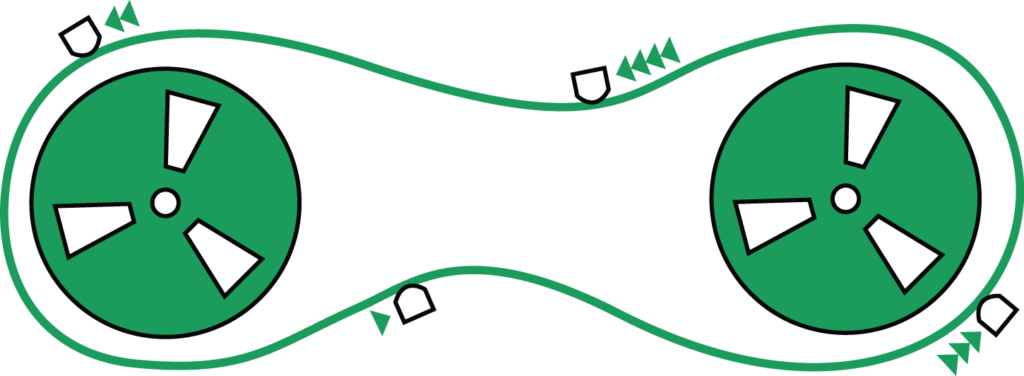
Magnetic Dance is a chordal micro-looper that you can use to create drones and ambient soundscapes. In this mode the pedal is constantly recording to a one second loop in the background. When you press Touch, 4 stereo tape heads start dancing around the loop. When each head reaches the end of the loop, it resets and jumps to a random starting point.
T1 — Controls the rate at which the tape heads move, with rates tuned to 4 note chords. Unity, octaves, and fifths sound great on almost all material. The rest generally sound best with single notes, or chords made up of octaves, perfect fourths, or perfect fifths.
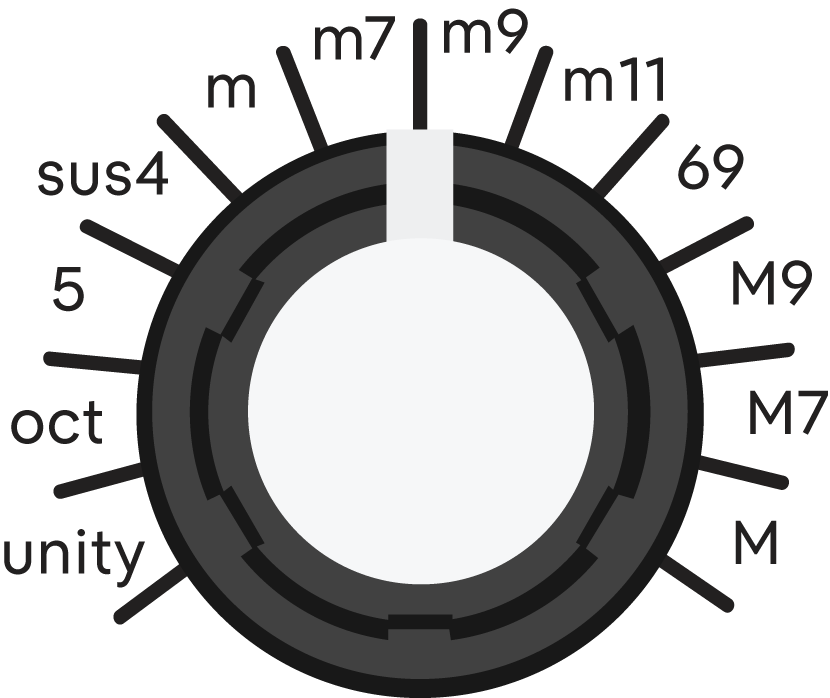
T2 – Controls the playback direction and volume of the tape heads. Clockwise from 12 noon will make the loop play forward, and counter-clockwise will reverse it. The playback volume increases as the knob moves toward the 12 noon position.
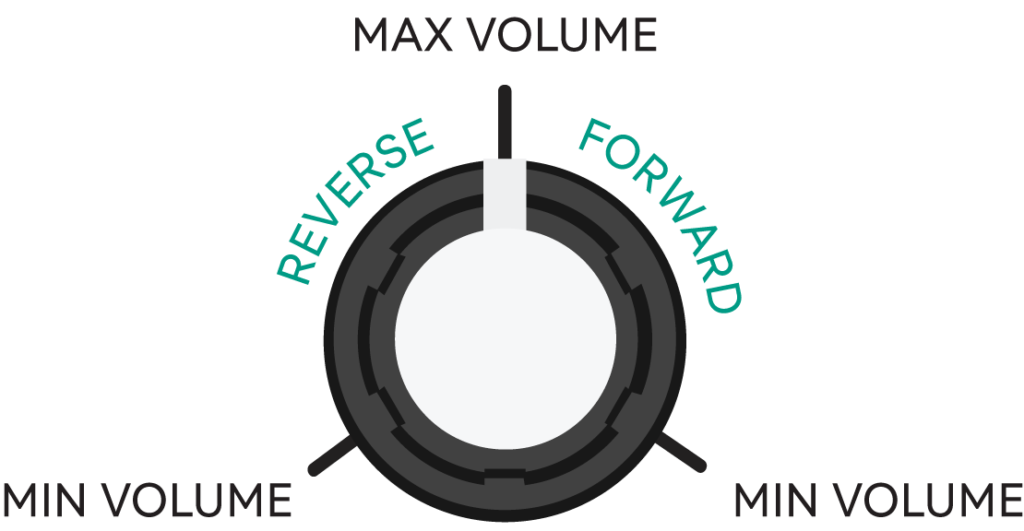
TAPE STOP (dark blue LED)

Tape Stop does exactly what you might expect. It slows down and bends the pitch of your audio in real-time. It’s responsive though and doesn’t have to come to a stop in one go — it can be slowed slightly then picked back up mid-stop, as if you were physically touching a reel of tape with your hand.
T1 — Controls how long it takes for your audio to reach a complete stop, ranging from 100 msecs (fully counter-clockwise) to 10 seconds (fully clockwise).
T2 — Controls how long it takes to catch back up, ranging from 100 msecs to 10 seconds.
BROKEN MACHINE (light blue LED)

You can use Broken Machine to add even more random tape modulation to your signal. At its minimum it can be used in subtle ways, similar to the wow and flutter parameters, then at its maximum you can get some really intense rewind effects or abrasive and totally unpredictable sounds.
T1 — Controls the depth or intensity of the effect.
T2 — Controls the chaos of the machine, so how often it does something random.
REPEATER (flickering green LED)
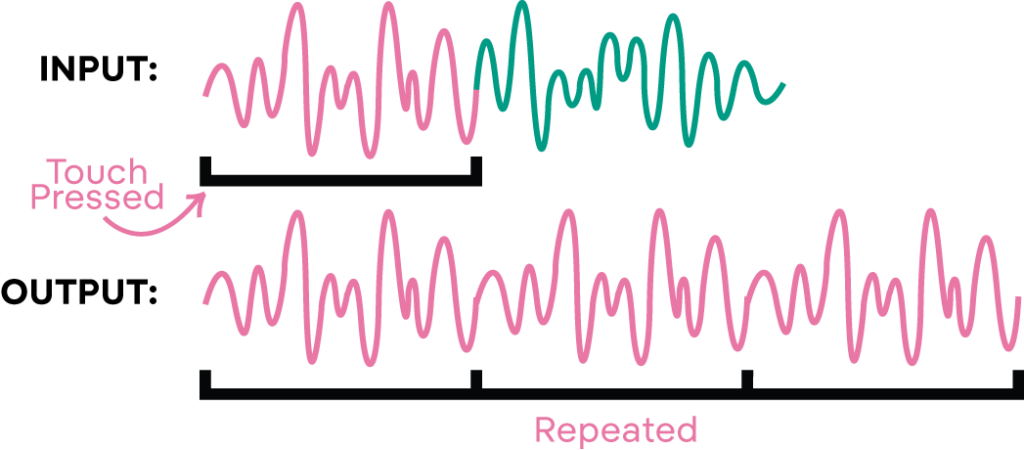
Repeater is an audio slicer that endlessly repeats a tiny loop and subdivides it for rhythmic or glitchy effects. It’s great with full mixes and is a lot of fun to play along with using a drum machine. You have the option to sync Repeater to your other devices with MIDI clock.
First, use Touch as a tap tempo to set the max length of your loop. Max is 1.2 secs and min is 166 msecs.
Now hold down Touch to record audio. When the next tempo downbeat is reached, your loop will automatically start playing back and endlessly repeat itself.
Keep Touch held down to maintain playback. If you let go the effect will stop. You can latch your Repeater loop by tapping Bypass while the Touch footswitch is being held down.
T1 — Controls the division of the loop length. Use longer subdivisions for more rhythmic sounds and shorter ones for glitchy effects in the vein of a skipping CD.

If you send Ribbons a MIDI clock while using Repeater, the clock overrides the tap tempo and sets the max size of your loop.
T2 — Controls the dry / wet mix of repeated audio and toggles between Standard or Resampling options.
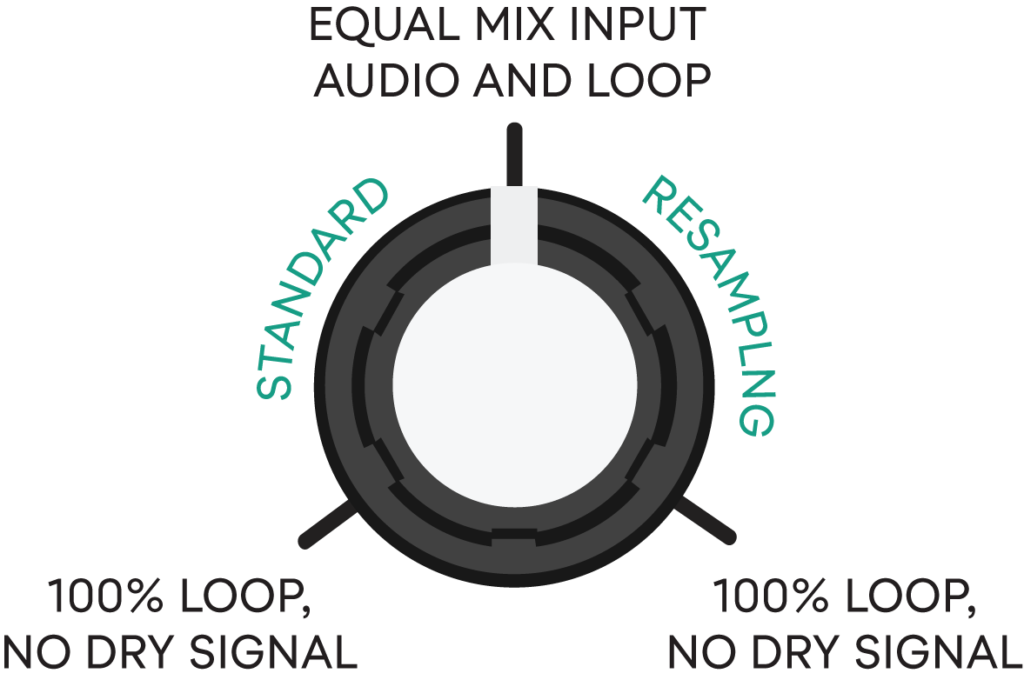
Standard Repeater — Samples new audio when the Touch footswitch is pressed.
Resampling Repeater — Can sample new audio by detecting transients, like a snare hit or a pick attack. Hands-free!
With Standard Repeater, the random section of the T1 knob picks a random subdivision each time the Touch footswitch is pressed. With Resampling, it picks a random subdivision each time a transient is detected. As you turn the T1 knob clockwise within that random section, it increases the probability of smaller subdivisions being used. Depending on your loop length, 1/8 and 1/16 can sound a little harsh, so by keeping the knob slightly counter-clockwise from 100% you can dial these out if you want to.
CRUSHED CASSETTE (flickering dark blue LED)

Crushed Cassette provides sample rate reduction and bit depth reduction with μ-law companding. Use this mode to emulate the sound of your favorite vintage sampler or lo-fi telecom systems of decades past.
T1 — Controls sample rate reduction from 48 kHz (hi-fi) down to 100 Hz. Turning the knob counter-clockwise reduces the sample rate, introducing aliasing and inharmonic sounds.
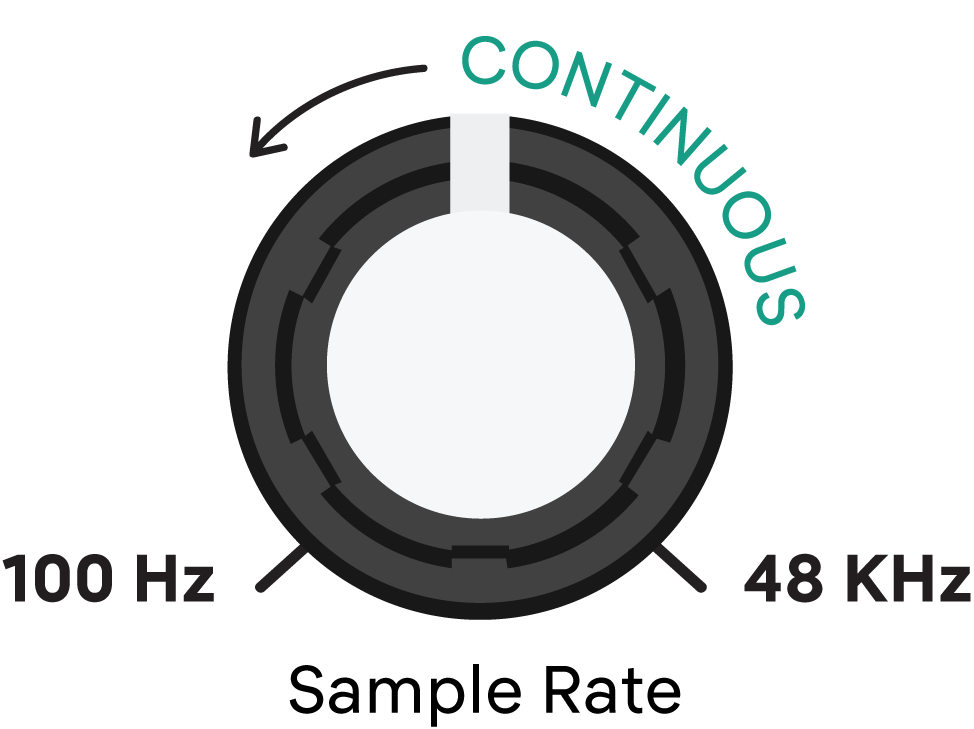
T2 — Controls the number of bits used to reproduce your signal, from 32 bits (hi-fi) down to 4 bits.
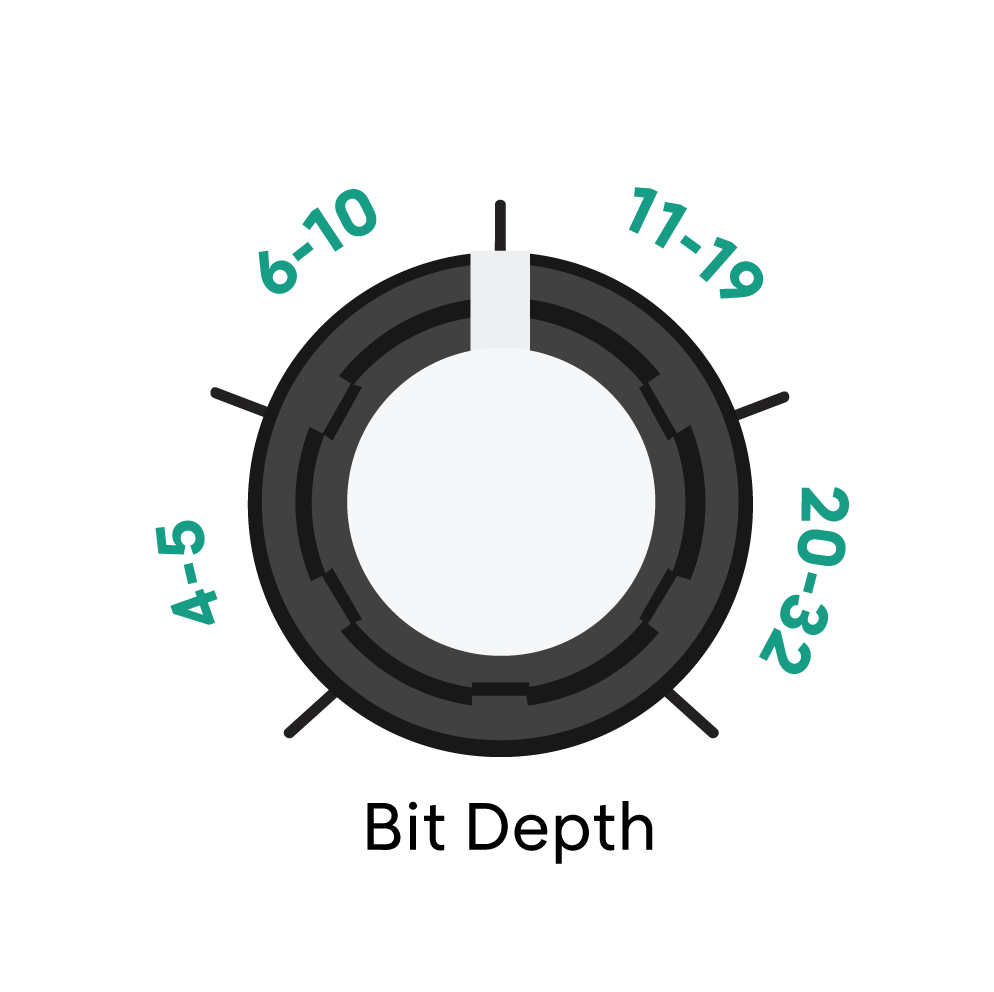
Most bit crushers have a gated quality where your signal abruptly disappears when it gets too quiet. μ-law companding prioritizes quiet parts of your signal, resulting in a bit crushed sound with lots of haunting distortion and artifacts, but without the gating effect so your signal decays more naturally.
At extremes, Crushed Cassette can introduce some pretty abrasive artifacts. You can use the low-pass filter on page 1 to reduce some of these while still maintaining interesting lo-fi textures.
DISINTEGRATION LOOP (flickering light blue LED)

Disintegration Loop is a sound-on-sound style looper with controls for decay, speed, and direction. It can be used in many ways, ranging from a simple tape delay to an experimental looper where your sounds age, distort, and become completely unrecognizable over time.
Combined with the reverb (pre-effects), you can create compositions reminiscent of Alvin Lucier’s famous 1969 piece “I am sitting in a room”, with the loop eventually becoming transformed and overtaken by resonant frequencies of the physical space.
There are 2 options to record to the loop:
- Hold down Touch to record, then release to stop.
- Tap Touch to start recording, then tap again to stop.
The first write sets the loop length. The Touch LED will ramp from zero to 100% brightness as your loop plays from start to finish.
Touch works like a write head, and when engaged a few things are happening:
- You are recording, so you can overdub new audio.
- Your loop can decay in volume.
- Your loop disintegrates. Each time it repeats it gets re-run through your effects. This provides many unique ways to slowly change and degrade your loop.
Try loading the Init preset before using this Touch Mode for the first time. Then you can slowly dial in effects while Touch is engaged to explore how they impact your loop over time.
T1 — Controls volume decay over time. Remember that Touch must be engaged for your loop to decay. If disengaged, it will maintain its current volume.
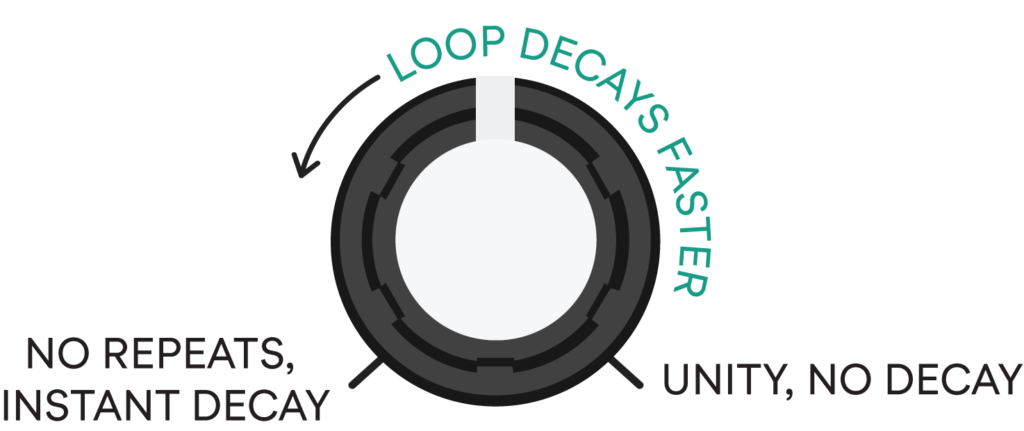
T2 — Controls speed and direction, and can be used to time stretch and reverse your loop. Try setting this knob around 9 or 3 o’clock when you record, that way you have room to both speed up or slow down.

If you modify T2 while overdubbing, speed and direction changes get printed to the loop in real-time, just like an actual tape player.
Double tap Touch to stop playback and erase your loop.
Four-Track Looper
Ribbons also features a four-track asynchronous looper. It can record up to 4 separate stereo loops that get processed through your effects, with a max recording time of 40 seconds per loop.
To enter / exit Looper Mode, hold down the push button and press Bypass. The Bypass LED turns light blue to show you are using the looper.
Press the push button to toggle between the 4 tracks. Each track has discrete controls for loop speed, speed scale, direction, and volume.
The default settings for each track are normal speed, continuous speed scale, forward direction, and 100% volume.
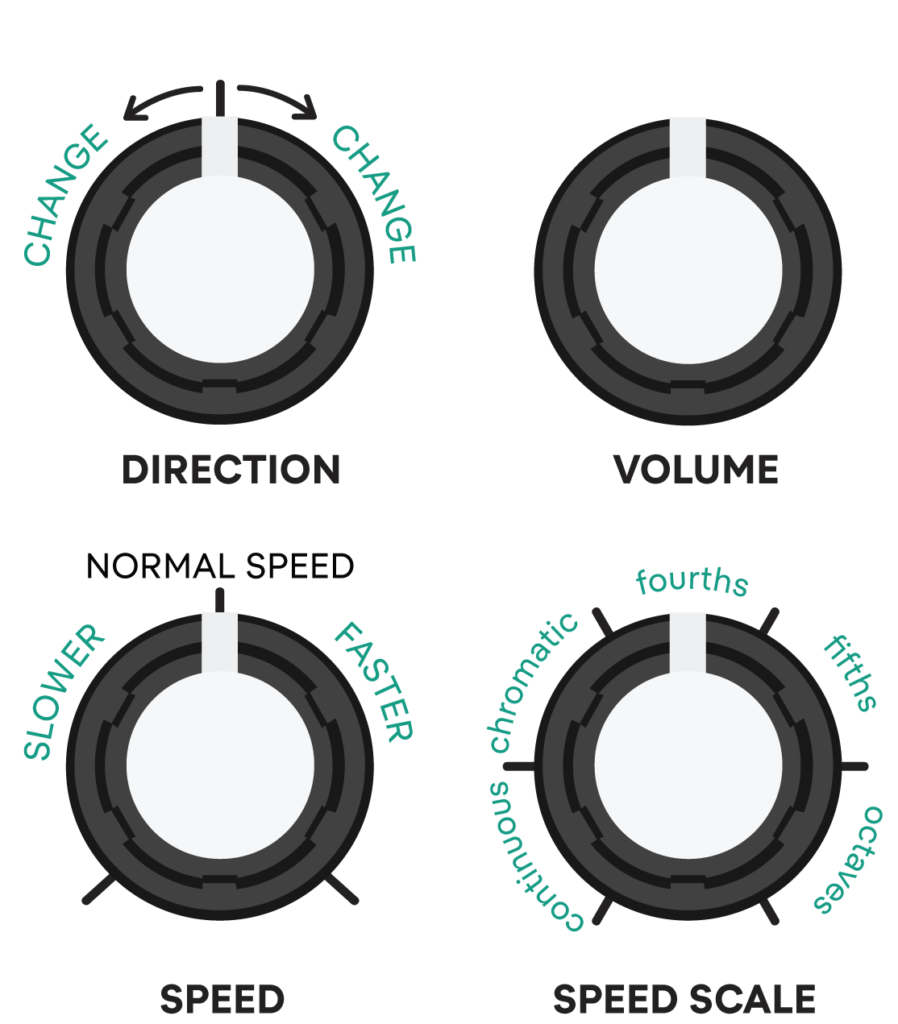
Recording and overdubbing
There are 2 options to record to a loop:
- Hold down Touch to record, then release to stop.
- Tap Touch to start recording, then tap again to stop.
The first write sets the loop length. The Touch LED will ramp from zero to 100% brightness as your loop plays from start to finish. Now you can re-engage Touch and overdub endlessly.
If you exceed the max loop length during the first write, Ribbons automatically switches from recording to overdubbing.
Record multiple layers of sound by overdubbing on a single track or recording to a new track. Overdubbing allows you to add layers that stay synchronized with the original loop, but you can't undo mistakes. Recording to a new track allows you to clear a loop if you make a mistake, but it may eventually drift out of sync with other tracks. If you'd like to sync your tracks to an external device you can do so using MIDI clock.
Stop / erase loops
To erase a single track, toggle to the track you want to clear then hold down the push button and tap Touch.
To erase all tracks simultaneously, hold down the push button for 3 seconds while on any track.
If you want to “stop” a track without erasing it, simply turn the volume for that track all the way down.
Speed knob (bottom-left)
The speed of each track can vary continuously from approximately 0.5x to 2x. Track speed impacts the length of your loop:
- 0.5x = 40-second max loop time (lowest quality)
- 1x = 20-second max loop time (normal quality)
- 2x = 10-second max loop time (highest quality)
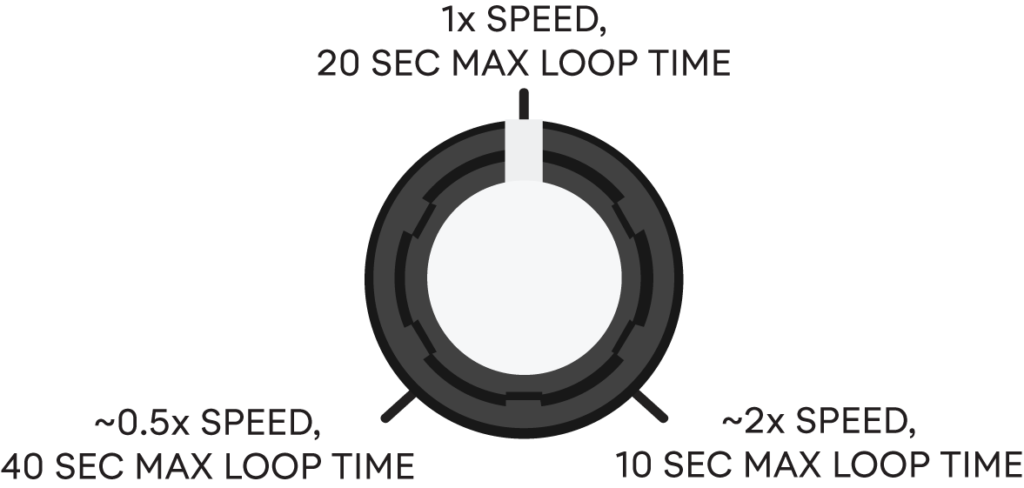
After recording to a loop, the sound will play back at the same pitch. If you turn up the speed knob, the pitch increases and your loop becomes shorter. Likewise if you decrease speed, the pitch drops and your loop becomes longer.
How the speed knob pitches your sound depends on your speed scale setting.
Speed Scale knob (bottom-right)
When you’re adjusting the speed of a loop, you may want to quantize the speed setting so that pitch changes sound more musical. Ribbons’ looper is designed to give you a few different scale options:
- Continuous (+/- 12 semitones; not quantized)
- Chromatic (+/- 12 semitones)
- Fourths (+/- 2 fourths)
- Fifths (+/- 2 fifths)
- Octaves (+/- 1 octave)
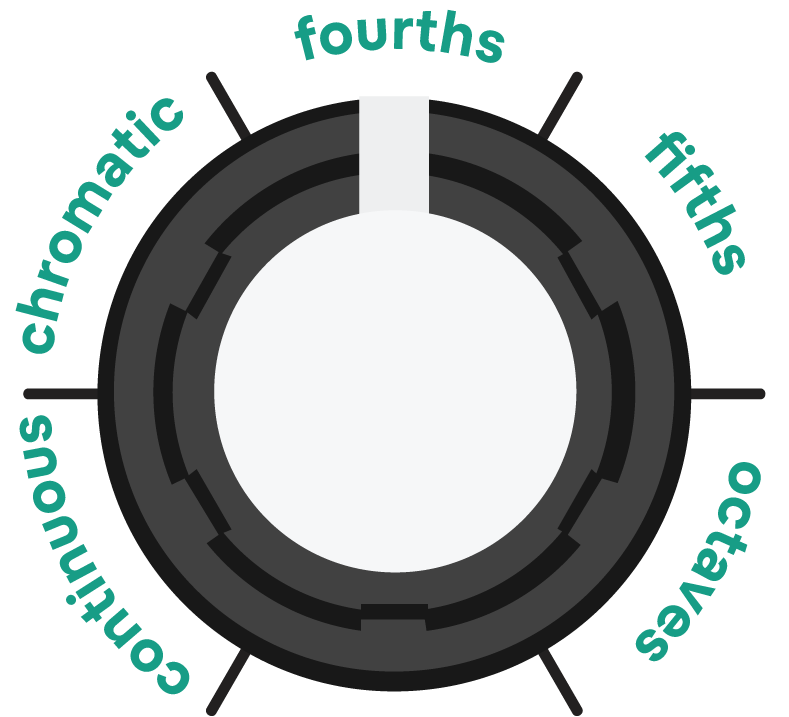
With the speed at 12 noon and speed scale at continuous, try setting a long empty loop container. Then tap in and overdub sparsely to build up your loop. Stop recording and slowly twist the speed knob counter-clockwise. You'll hear your audio smoothly pitch down a whole octave.
Direction knob (top-left)
Track direction works just like a tape player that’s capable of bi-directional recording. It can be used to reverse the playback direction of any particular loop.
Try recording to a loop, then change its direction. It will play in reverse. Now if you overdub, the new audio plays forward while the original loop still plays in reverse. If you switch directions again, the original loop will play forward while the new audio plays in reverse.
Volume knob (top-right)
This one is easy. You get a volume control for each looper track. Leave this turned up when you record if you want to hear playback immediately. You can also set the volume to zero before recording and increase it during playback to swell in your loop.
The volume control is a handy way to introduce changes during playback more subtly. For example, if you have multiple loops playing asynchronously, you can momentarily turn the volume down on one track, reverse the track direction, and then increase the volume again. The loop now plays in reverse but you avoid the dramatic change at 12 noon.
Looper + Tape Effects
You can modify your tape effects while loops are playing back. Apply the same button combo you used to enter Looper Mode (hold down the push button and press Bypass). The Bypass LED turns green to show that you are back in normal operation.
Now you can adjust the filters, add reverb, or modify any of the other effects. Changes you dial in are applied to your loops in real-time.
You must re-enter Looper Mode to keep playing with the looper, or to stop and erase tracks.
Touch Modes are disabled if loops are playing back. There just isn’t enough processing power to run them simultaneously. However, if you’re editing tape effects with the looper active, Touch becomes a Tape Stop effect for your loops. To access the Touch Modes again, clear all tracks.
Looper + MIDI
Ribbons can take a jittery MIDI clock and generate a stable internal clock that stays locked with the grid / beat. This can be used to quantize your loop lengths and synchronize the looper with your favorite drum machine, sequencer, or DAW.
When a clock is received, the 4th LED (red hand) will start blinking on each of the looper tracks. This is Ribbons’ way of indicating where it thinks the downbeat is. If it doesn’t match your drum machine, sequencer, or DAW, then you’ll need to send Ribbons a MIDI Start message to tell it where the downbeat is. Once received, Ribbons will be synced with your device(s).
To record, engage Touch slightly before the beat where you want your recording to start. Disengage slightly before the end of the final bar you want to record to.
Ribbons ensures that the max loop time is some division of the grid so that if you exceed it your loop stays within the grid. If you exceed the max loop time, Ribbons automatically switches from recording to overdubbing.
During loop playback, Ribbons applies micro-timing adjustments to prevent loops from drifting out-of-sync with the grid.
The speed scale knob is disabled when MIDI clock is applied. The speed knob provides 3 options: 0.5x, 1x, or 2x. The direction and volume knobs function the same. Speed and direction changes go into effect when your loop wraps around to the start.
OTHER NOTES: We do not recommend sending MIDI clock tempo changes to Ribbons while loops are playing back. If a loop is recorded at one tempo and changed to another tempo during playback, Ribbons will attempt to time stretch and pitch shift the loop to stay within the grid. However, it will likely lose the downbeat during re-synchronization and produce unexpected behavior. Also, Ribbons expects a constant clock to be applied while using the looper. So if you're using Ribbons with a DAW and pressing Start and Stop while loops are playing back, you may also get unexpected behavior as your loops attempt to re-synchronize with the downbeat. Finally, the looper's Tape Stop effect is disabled when MIDI clock is applied. This ensures that your loops stay synchronized with the grid.
MIDI Overview
Ribbons is directly compatible with all non-USB-style MIDI controllers. Use a TRS to DIN MIDI cable to connect to Ribbons’ MIDI input. This post on our forum lists some verified cable solutions.
Ribbons can manage 3 different types of TRS MIDI connections: Type A (factory setting), Type B, or Type CBA.
If you need to switch types, you can move both jumpers on the inside of the device up or down, per the image below. The jumpers should always be treated as a set and sit side by side.
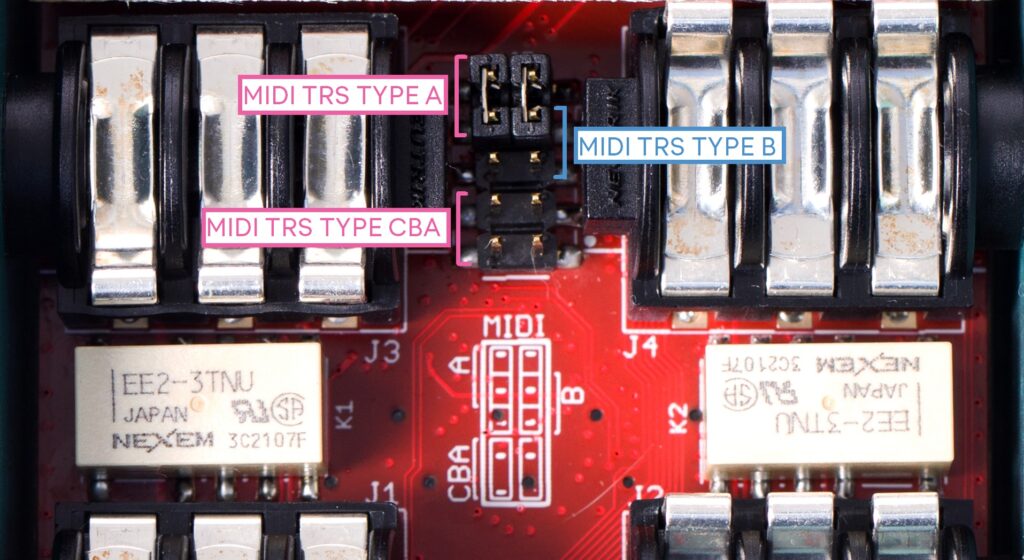
IMPORTANT: Take extreme care when performing this step and only touch the MIDI jumpers. Electrostatic discharge (ESD) to internal components can easily damage Ribbons.
- TRS Type A
Default setting — MIDI standard, Korg, Make Noise, etc.- MIDI 4 (Source) to TRS RING
- MIDI 2 (Shield) to TRS SLEEVE
- MIDI 5 (Sink) to TRS TIP
- TRS Type B
Arturia, Novation, 1010music, etc.- MIDI 4 (Source) to TRS TIP
- MIDI 2 (Shield) to TRS SLEEVE
- MIDI 5 (Sink) to TRS RING
- TRS Type CBA
Chase Bliss Audio MIDI Box. Connection used by Chase Bliss and some other pedal manufacturers. If you use this configuration, we recommend using a short TRS cable (~2 feet) to guarantee reliable transmission.- TRS to TRS (no crossed wires)
MIDI channels
Ribbons defaults to MIDI channel 1. To change MIDI channels, make sure nothing is connected to the CV / EXP input and hold down both footswitches while applying power. A single LED will light up, and now you can use the push button to toggle between 16 available MIDI channels.
- To select a MIDI channel, press Touch.
- To exit without selecting, press Bypass.
After selecting or exiting Ribbons will boot up normally. The MIDI channel you select is persistent between power cycles.
MIDI CC messages
Ribbons’ controls can all be modified via various MIDI CC messages. It responds to the following:
| MIDI CC #: | Destination: | Range: |
| 0 | High-Pass Filter | 0-127 |
| 1 | Low-Pass Filter | 0-127 |
| 2 | Mix | 0-127 |
| 3 | Compression / Saturation | 0-127 |
| 4 | Wow Frequency | 0-127 |
| 5 | Wow Depth | 0-127 |
| 6 | Flutter Depth | 0-127 |
| 7 | Flutter Frequency | 0-127 |
| 8 | Dropouts Frequency | 0-127 |
| 9 | Dropouts Depth | 0-127 |
| 10 | Crinkle | 0-127 |
| 11 | Noise | 0-127 |
| 12 | Reverb Decay | 0-127 |
| 13 | Reverb Mix & Placement | 0-127 |
| 14 | Touch Param 1 | 0-127 |
| 15 | Touch Param 2 | 0-127 |
| 16 | Touch Footswitch | 0 = Off ≥1 = On |
| 17 | Bypass Footswitch | 0 = Off ≥1 = On |
| 18 | Touch Mode Select | 0 = Magnetic Dance 1 = Tape Stop 2 = Broken Machine 3 = Repeater 4 = Crushed Cassette 5 = Disintegration Loop |
| 19 | Ribbons Mode Select | 0 = Tape Effects 1 = Looper |
| 20 | Change Looper Track | 0 = Track 1 1 = Track 2 2 = Track 3 3 = Track 4 |
| 21 | Clear Current Looper Track | 0 = False ≥1 = True |
| 22 | Clear All Looper Tracks | 0 = False ≥1 = True |
| 23 | Track 1 Direction | 0-127 |
| 24 | Track 1 Speed | 0-127 |
| 25 | Track 1 Volume | 0-127 |
| 26 | Track 1 Scale | 0-127 |
| 27 | Track 2 Direction | 0-127 |
| 28 | Track 2 Speed | 0-127 |
| 29 | Track 2 Volume | 0-127 |
| 30 | Track 2 Scale | 0-127 |
| 31 | Track 3 Direction | 0-127 |
| 32 | Track 3 Speed | 0-127 |
| 33 | Track 3 Volume | 0-127 |
| 34 | Track 3 Scale | 0-127 |
| 35 | Track 4 Direction | 0-127 |
| 36 | Track 4 Speed | 0-127 |
| 37 | Track 4 Volume | 0-127 |
| 38 | Track 4 Scale | 0-127 |
| 51 | Ignore MIDI Clock | 0 = Ignore ≥0 = Listen |
| 52 | Compression / Saturation | 0 = Compression ≥1 = Saturation |
| 53 | Synth Attack | 0-127 |
| 54 | Synth Release | 0-127 |
| 55 | Synth Volume | 0-127 |
Loading presets with MIDI
To load one of the 8 preset slots using MIDI, send a Program Change message to Ribbons with a value of 1-8. A Program Change of 1 will load preset 1, a Program Change of 7 will load preset 7, etc. A Program Change of 0 or >8 will not select any preset.
Max for Live
Ableton users can download our Max for Live devices to control Ribbons with MIDI. These can be found on the Ribbons product page under the Extras tab. You’ll find 2 devices: one to control all of the different tape effects and Touch Modes, and another for controlling the looper.


Sine Wave Synthesizer
Ribbons has an internal four-voice sine wave synth that can be processed using all of the tape effects, Touch Modes, and four-track looper. Just plug in and play — the synth and your incoming audio get mixed together and run through all of the effects.
To use the sine wave synth, connect a MIDI keyboard and start sending MIDI note data. You can also send a Pitch Bend message to smoothly bend the pitch of notes +/- 5 semitones.
MIDI CC messages 53, 54, and 55 allow for control over the synth attack, release, and volume.
Try messing with the tape effects while playing the synth to dial in spooky mellotron-like sounds. Since the sine waves are so pure they make a great starting point for building textures.
CV / Expression
You can use the CV / EXP input to map Ribbons’ parameters using control voltage or an expression pedal. The CV / EXP input has a range of 0-5 volts.
To access the CV / EXP Mapping Menu, make sure that a TS or TRS cable is connected to the CV / EXP input, then hold down both footswitches while applying power. The footswitch LEDs will turn light blue.
- Press the push button to toggle between 9 pages of mappable parameters.
- Use the top-left knob to scroll through the parameters on any given page.
- Press Touch to map / unmap a parameter. After pressing Touch to map, try slightly rotating the top-left knob to change the index. If the LED glows white, this shows you that the parameter has been mapped.
- When you are done mapping parameters, you must press Bypass to save your settings and exit. Ribbons will boot up normally.
If you look carefully, you'll notice that settings for the mapping menu are laid out using the same color and page layout as the device itself, working clock-wise from the bottom-left knob.
- Page 1 — Mix and Utility (green)
- High-pass, Low-pass, Mix, Compression or Saturation
- Page 2 — Wow and Flutter (blue)
- Wow frequency, Wow depth, Flutter depth, Flutter frequency
- Page 3 — Degradation (pink)
- Dropouts frequency, Dropouts depth, Crinkle, Noise
- Page 4 — Reverb, Touch Modes (red)
- Reverb depth, Reverb mix & placement, Touch Param 1, Touch Param 2
- Pages 5-8 — Looper mapping. Each page represents a looper track (page 5 = green, page 6 = blue, page 7 = pink, page 8 = red)
- Speed, Direction, Volume, Speed scale
- Page 9 — Touch footswitch. Only one parameter on this page
- All LEDs light up if mapped, and are blank if unmapped.
When a parameter is mapped to CV / EXP, the knob itself during normal operation sets the midpoint of the expression pedal (+2.5V). If you rock the expression pedal to the heel position (0V), it will set the parameter to its minimum value. Likewise, if you rock the expression pedal to the toe position, it will set the parameter to its max value (+5V).
If the Touch footswitch is mapped to CV, it will engage when a CV > 2.5V is applied, and disengage when a CV < 2.5V is applied.
Mixing and Bypass Options
To access the Mixing Menu, hold down Touch while applying power to Ribbons. The page LEDs will indicate your current mix setting. You can toggle between 3 options using the push button. After saving or exiting Ribbons will boot up normally.
- To save a new setting press Touch
- To exit the menu press Bypass
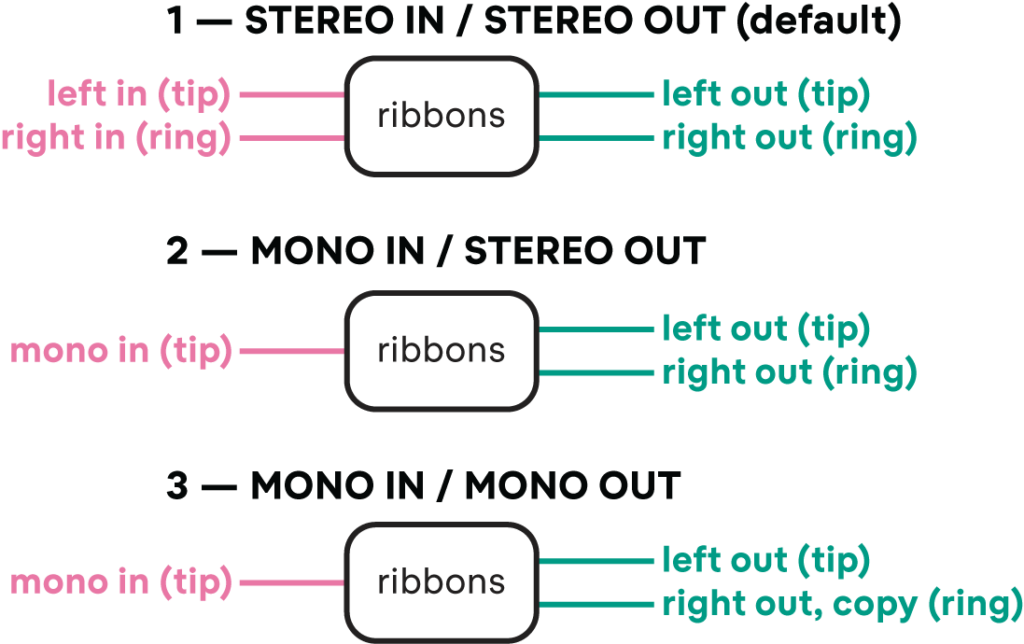
To access the Bypass Menu, hold down Bypass while applying power to Ribbons. The page LEDs will indicate your current bypass setting. You can toggle between 3 options using the push button. After saving or exiting Ribbons will boot up normally.
- To save a new setting press Touch
- To exit the menu press Bypass
1 — TRUE BYPASS (default)
Uses a mechanical relay to completely bypass Ribbons’ electronics when the pedal is disengaged.
2 — BUFFERED BYPASS
A silent switching option where your audio still runs through Ribbons’ electronics when disengaged.
3 — BUFFERED BYPASS WITH TRAILS
Another silent switching option, where your input signal will no longer be affected but the device still acts as a sound source, so you’ll continue to hear certain effects being generated (reverb tails, noise, looper, etc).
If you have Ribbons configured for mono in / stereo out, select one of the buffered bypass options. Mixing and bypass settings are persistent between power cycles, so you only need to visit these menus if you want to change them.
Factory Reset
To restore all of the factory presets and default mixing and bypass settings, you can perform a quick factory reset on your unit. This option was introduced in firmware v1.2, so users with earlier Ribbons may need to update their firmware as a first step.
To perform a factory reset, hold down the push button for 3 seconds to enter the Presets Menu. Then, hold down the push button and double tap Touch. After about 5 seconds Ribbons will reboot on its own. Do not remove power during the reset process.
Take care to release the push button after that second tap of the Touch footswitch. If you are holding down the push button during the reset / bootup sequence, then you enter bootloader mode, which is what Ribbons looks like when it’s ready to receive a firmware update file (all LEDS on the device will start to glow). If you do this by accident, no worries at all. Just remove and re-apply power to and you’ll be back to normal operation.
If your unit is configured for saturation via MIDI, performing a factory reset also restores compression. Remember that if your goal is to simply clear your current effects and start over with a blank slate, you can load up the Init preset.
Firmware Updates
Occasionally we may release new firmware to address bugs or improve features. If you have a Ribbons from 2022 you will need to update your device in order to access the latest features.
The firmware update process for Ribbons is fast and easy — you simply play a .wav file into the device.
For a more hands-on tutorial check out our video guide.
To start, we must warn you that the firmware update file is not meant for listening and playing it back at loud volumes could potentially damage your hearing or other pieces of equipment. Do not connect Ribbons’ output to any other equipment until the update process is complete.
- Download the correct .wav file from the Ribbons Development Blog.
- Prepare your setup to play back the audio file (from your PC, smartphone, tablet, or audio interface). Make sure that your device will not “normalize” or alter the volume of the audio file (e.g. turning off Sound Check if using iTunes / Apple Music).
- Set your audio output to ~75%.
- Confirm that your playback device will not emit any unexpected sounds or notifications during the update process.
- Connect a TS or TRS cable to Ribbons’ input jack and connect the other end to your playback device.
- Power down Ribbons by disconnecting the power.
- Hold down the push button while applying power to to enter bootloader mode. All of the LEDs on Ribbons should be glowing, indicating that it’s ready for a firmware update.
- Start playing the .wav file. After a few seconds, both footswitch LEDs should start blinking green, indicating that packets of data are being received.
- Wait until the audio file has finished playing back.
- If the update is successful, Ribbons will boot up normally.
- If the update fails, then various LEDs may light up red, or the pedal may not boot normally. In this scenario you will need to try the update process again. If you ever run into issues we can help you troubleshoot your setup. It’s often as simple as a faulty cable. We have installed the firmware on every single Ribbons using this method and it has always been reliable.
If you believe you’ve discovered a firmware bug, email support@kinotoneaudio.com or share your findings on the Kinotone forum.
A note about startup behavior
When Ribbons boots up, it goes through a startup sequence where the 4 LEDs all light up in a row. It runs tests to confirm that the internal memories are working as expected. If Ribbons fails a test when booting up it would throw an error code using the 4 LEDs. If you ever encounter a startup error please report it by emailing support@kinotoneaudio.com and we can help you resolve it.
